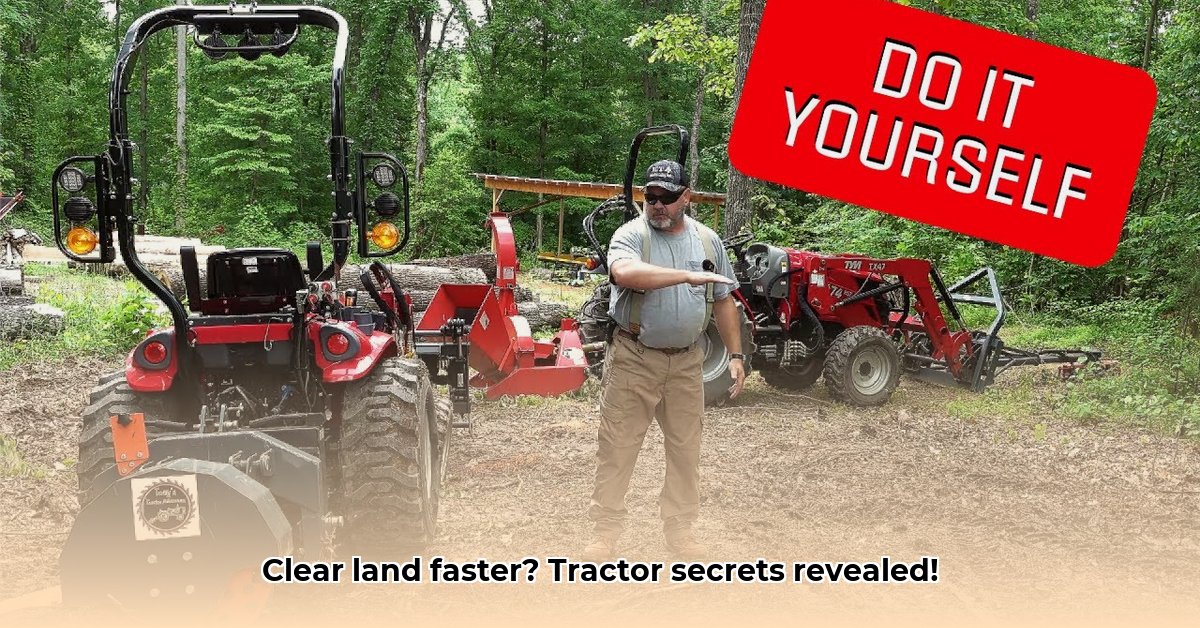
Ready to transform your overgrown land into a productive space? Clearing land with a tractor can be efficient and sustainable, but requires careful planning and execution. This guide provides a step-by-step approach, focusing on minimizing environmental impact and maximizing efficiency. Whether you're a seasoned farmer or a first-timer, we'll equip you with the knowledge to tackle this task effectively. For more on using tractors for other tasks, check out our guide on digging trenches.
Planning & Preparation: Setting the Stage for Success
Thorough preparation is crucial for a successful and safe land-clearing project. Begin by assessing your land, noting its size, terrain (flat, hilly, rocky), and vegetation density. This assessment dictates the type of tractor and attachments needed. Underestimating or overestimating your needs can lead to costly mistakes. Do you need a compact tractor for a smaller area or a more powerful machine for a larger, more challenging site?
Next, obtain all necessary permits and permissions from local authorities. Ignoring regulations can result in hefty fines and legal complications. This step is essential to avoid future setbacks.
Choosing the right equipment is paramount. For smaller properties and less challenging terrain, a compact tractor may suffice. Larger-scale projects or rough terrain demand a larger, more powerful tractor. Essential attachments include:
- Brush Hog (Rotary Cutter): Effectively cuts down brush, weeds, and small saplings. (A powerful mowing machine for clearing vegetation.)
- Root Rake: Removes tree stumps and roots. (A heavy-duty attachment designed for removing stubborn tree roots and stumps.)
- Box Blade: Levels the ground, removes debris, and creates drainage ditches. (A versatile tool for land grading and leveling.)
Safety is paramount. Always wear appropriate Personal Protective Equipment (PPE), including safety glasses, gloves, sturdy boots, and hearing protection. Familiarize yourself with your tractor's manual and understand all safety features before operation. Neglecting safety can lead to serious injury.
Step-by-Step Clearing Process: A Practical Approach
The clearing process involves a series of steps, each utilizing specific tractor attachments for optimal efficiency:
Initial Clearing (Brush Hog): Begin by mowing down the majority of vegetation with the brush hog. Overlap passes to ensure complete coverage. Multiple passes may be necessary depending on vegetation density. This initial clearing paves the way for subsequent steps.
Stump Removal (Root Rake): Once the above-ground vegetation is cleared, use the root rake to remove tree stumps and roots. This step requires patience and may need several passes, especially for large or stubborn roots. Proper removal is essential for a level and safe work area.
Grading and Leveling (Box Blade): After removing debris, use the box blade to level the ground. This prepares the area for planting, construction, or other intended uses. This final step ensures proper land preparation for future use.
Post-Clearing Procedures: Sustainable Land Management
Sustainable land clearing extends beyond simply removing vegetation. It includes protecting the land for long-term health and productivity. Avoid burning debris whenever possible, as it can be environmentally harmful and often restricted by regulations. Instead, consider chipping or mulching the remaining brush. This creates mulch which reduces erosion and improves soil health. Mulching also returns organic matter to the soil.
Planting cover crops after clearing helps restore soil health and prevent erosion. Cover crops enhance soil fertility and reduce nutrient runoff. Long-term land management planning, including crop rotation and sustainable farming practices, is crucial for preserving the land's productivity.
Addressing Risks: Proactive Mitigation Strategies
Even with meticulous planning, unforeseen challenges can arise. Understanding potential risks and developing mitigation strategies is essential:
| Risk Category | Potential Problem | Mitigation Strategy |
|---|---|---|
| Soil Erosion | Loss of topsoil, soil degradation | Mulching, cover cropping, terracing, contour plowing |
| Environmental Damage | Harm to wildlife habitats, water pollution | Minimize disturbance, proper waste disposal, avoid sensitive areas |
| Equipment Malfunction | Tractor breakdowns, attachment failures | Regular maintenance, operator training, contingency planning |
| Regulatory Non-Compliance | Fines, legal issues | Obtain necessary permits, adhere strictly to regulations |
Careful planning and execution of the land-clearing process are key to minimizing these risks. Consulting with experienced professionals, especially for larger or more complex projects, can provide invaluable support and expertise.
Conclusion: Towards Sustainable Land Use
Clearing land with a tractor can be a highly effective process when approached with a sustainable mindset. By following these steps and prioritizing safety and environmental responsibility, you can efficiently prepare your land for its intended use while preserving its long-term health. Remember to consult local regulations and consider seeking expert advice for optimal results. This thoughtful guide empowers you to make informed choices during land clearing, promoting both your project's success and the preservation of valuable natural resource.